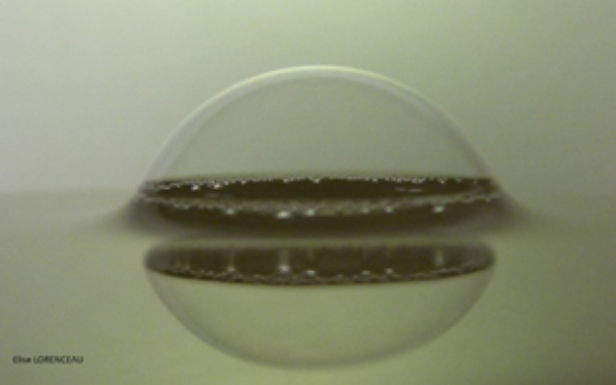The lifetime and the bursting of a single bubble at the surface of liquid bath is still an open question even so its understanding as interests in the optimization of industrial processes (foam formation, aerosol generation) but also in the description of natural phenomena.
We developed in our lab a dedicated experimental set-up that allows the automatic creation of thousands of successive single bubble at the surface of a liquid bath to measure their lifetime and study the statistics of the events.

In the case of single bubble at the surface of an alcohol-water liquid bath, the average lifetime increases with the alcohol concentration (range 0-12% g/g). The experimental data are highly dispersed and extend over three decades, from 0.1 to 100 s. The normalized lifetime probability density functions are independent of the alcohol concentration and relatively well described by a Weibull distribution with an exponent of 4/3. We compare our experimental data with the predictions of a recent model highlighting the importance of Marangoni stresses induced by water contaminants to the fate of a bubble. In our case, these Marangoni stresses are probably induced by heterogeneities in the alcohol concentration maintained by evaporation.
In the case of big bubble at the surface of soap solutions (presence of surfactant that stabilize the liquid film), the average lifetime increases with the bubble size and as well as with the atmospheric humidity. On one side, a model of the drainage under saturated water vapour considering both capillary and gravity driven drainage provides a very good prediction of film thinning experiment. On another side, for experiments conducted far from saturation, the convective evaporation of the bath is shown to dominate the overall mass loss in the cap film due to evaporation. We make use of a model based on the overall thinning dynamics (drainage and evaporation) of the thin film and assume a rupture thickness of the order 10-100 nm to obtain a good representation of these experimental data.
The addition of sweeteners in fizzy beverages not only affects the sugar content but also the bubbles stability. We show that the bubbles are indeed more stable in presence of sweeteners, which are surface active molecules and adsorb at the interface. Additionally, we test an antifoam at different concentrations and show that our experiment allows to identify the best concentration to reproduce the stability obtained in sucrose when we replace this latter by a sweetener.
Related Papers :
– Lifetime of a single bubble on the surface of a water and ethanol bath, E. Lorenceau, F. Rouyer, Phys. Rev. Fluids, (2020).
– Stability of Big Surface Bubbles: Impact of Evaporation and Bubbles Size, J. Miguet, M. Pasquet, F. Rouyer, Y. Fang, E. Rio, Soft Matter (2020)
– How does the presence of stevia glycosides impact surface bubbles stability? , J. Miguet, F. Rouyer, Y. Fang and E. Rio, Colloids and Surfaces A, (2020).
– The Life of a Surface Bubble, J. Miguet, F. Rouyer, and E. Rio, Molecules (2021)


